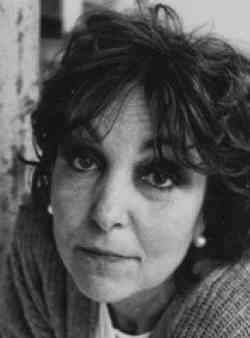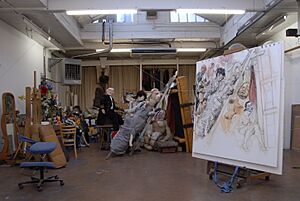Paula Rego facts for kids
Quick facts for kids
Paula Rego
|
|
|---|---|
 |
|
| Born |
Maria Paula Figueiroa Rego
26 January 1935 Lisbon, Portugal
|
| Died | 8 June 2022 (aged 87) London, England
|
| Nationality | Portuguese/British |
| Known for | Painting, printmaking |
| Spouse(s) |
Victor Willing
(m. 1959; |
| Awards | Dame Commander of the Most Excellent Order of the British Empire Grand Cross of the Order of Saint James of the Sword Grand Officer of the Order of Saint James of the Sword Grand Collar of the Order of Camões |
Dame Paula Rego (born January 26, 1935 – died June 8, 2022) was a famous Portuguese-British artist. She was known for her amazing paintings and prints. Many people think she was one of the most important female artists of her time.
Paula Rego's art often showed stories and fairy tales. Her style changed over time, becoming more realistic. She loved using pastels more than oil paints. Her work also often explored ideas about feminism, mixed with traditional Portuguese folk stories.
She studied at the Slade School of Fine Art in London. She was part of a group called The London Group with other well-known artists. Later, she became an artist-in-residence at the National Gallery in London. This meant she got to work and create art right inside the famous museum! Paula Rego lived and worked in London for most of her life.
Contents
Paula Rego's Early Life
Paula Rego was born in Lisbon, Portugal, on January 26, 1935. Her father was an engineer who worked for the Marconi Company. He was strongly against unfair governments. Her mother was also a good artist, but she didn't encourage Paula to become an artist herself. Paula started drawing when she was only four years old.
In 1936, her parents moved to the United Kingdom for her father's job. Paula stayed in Portugal with her grandmother until 1939. Her grandmother was very important to her. She taught Paula many traditional folktales and stories. These stories later inspired many of Paula's artworks.
Paula's family loved English culture. So, Paula went to the only English school in Lisbon, Saint Julian's School, from 1945 to 1951. This school was Anglican, which is a type of Christian church. This, and her father's views, made Paula feel a bit different from the strong Roman Catholic beliefs common in Portugal.
Paula Rego's Education
In 1951, Paula was sent to a finishing school in England. She wasn't happy there. In 1952, she wanted to study art at the Chelsea School of Art in London. However, her guardian in Britain suggested the Slade School of Fine Art instead. He thought it was a more suitable place for her.
From 1952 to 1956, Paula Rego studied at the Slade School. This is where she really started to develop her artistic skills.
Paula Rego's Art Career
Paula Rego's art career truly began in 1962. She started showing her work with The London Group. This was a famous group of artists that included David Hockney. In 1965, her art was shown in a group exhibition in London. That same year, she had her first solo show in Lisbon, Portugal.
She also represented Portugal at a big art event in Brazil in 1969. Between 1971 and 1978, she had many solo shows in Portugal. Then, she had several exhibitions in Britain, including at the AIR Gallery in London in 1981.
In 1988, a special exhibition of her work was held in Lisbon and London. Because of this, she was invited to be the first Associate Artist at the National Gallery in London in 1990. This was a new program where artists could work closely with the museum's collection.
This experience led to two important series of works. One was a group of paintings and prints based on nursery rhymes. These artworks traveled around Britain and other countries. The second was a series of large paintings inspired by the works of Carlo Crivelli at the National Gallery. These are known as Crivelli's Garden.
In 1995, Paula Rego used pastels to create her drawing Swallows the Poisoned Apple. This artwork showed Snow White after eating the apple. It explored themes of aging and what women experience in life. At the time, Rego was about 60 years old, and her age influenced this powerful piece.
Her work was shown in many other important museums. These included Tate Liverpool in 1997 and Tate Britain in 2005. A major exhibition of her art was held in Madrid in 2007. It then traveled to Washington, D.C.
In 2008, Rego had an exhibition in New York. She also had a show of her prints in France. In 2010, another exhibition of her work was held in London. Her art was also shown in Mexico and Brazil. In 2011, she appeared in a documentary about another artist, where she shared her experiences.
The Royal Mail asked Paula Rego to create a set of stamps in 2004. These stamps were based on the famous story of Jane Eyre. In 2017, a BBC documentary called Paula Rego, Secrets & Stories was made about her. It was directed by her son, Nick Willing.
Paula Rego's art was part of the "Women Painting Women" exhibition in 2022. In 2023, some of her art was shown at the Pera Museum in Istanbul. Her works are now in many public and private collections around the world. The British Council has 43 of her works, and the Tate Gallery in London has 48.
Paula Rego's Personal Life
Paula Rego married Victor Willing in 1959. They had three children: Caroline, Victoria Willing, and Nick Willing. Nick is a filmmaker who directed the documentary about his mother. The famous sculptor Ron Mueck is her son-in-law.
In 1962, Paula's father bought them a house in London. Paula spent her time living between Britain and Portugal.
After her father passed away in 1966, her husband Victor took over the family's electrical business. However, Victor became ill, and the company faced difficulties. In 1974, Paula, Victor, and their children moved to London permanently. They lived there until Victor's death in 1988.
Paula Rego was a big fan of the football club S.L. Benfica. Her grandfather was one of the people who helped start the club.
Paula Rego passed away on June 8, 2022, at the age of 87. She was buried with Victor Willing in Hampstead Cemetery.
Paula Rego's Art Style
Paula Rego was a very active painter and printmaker. Early in her career, she also made collages. Her famous artworks, made after 1990, often showed folk tales and images of young girls. These works used strong, clear lines, which was different from her earlier, looser style.
In her first works, like Always at Your Excellency's Service from 1961, Paula Rego was inspired by Surrealism. This art style tries to show the strange and dreamlike parts of the mind. She used a method called "automatic drawing." This is where the artist tries to draw without thinking too much, letting their unconscious mind guide them. Sometimes, these early paintings looked almost abstract.
In the 1960s, Paula Rego used a more abstract style for a few reasons. At that time, abstract art was very popular. Also, she was reacting against her training at the Slade School, where they focused a lot on drawing the human body perfectly. With encouragement from her husband, Victor, Paula kept a "secret sketchbook" where she drew freely. This was different from what her teachers wanted.
A big change in Paula Rego's style happened in 1990. This was when she became the first Associate Artist at the National Gallery in London. Her job was to create new art that connected to the museum's collection of old master paintings. This experience made her go back to a clearer, more detailed drawing style. This new style became what most people know her for: strong, clear drawings showing equally strong women.
Works like Crivelli's Garden were clearly linked to the paintings by Carlo Crivelli in the National Gallery. Other works, like Joseph's Dream, were inspired by old masters like Diego Velázquez.
Paula Rego stopped making collages in the late 1970s. In the early 1990s, she started using pastels a lot. She continued to use pastels almost exclusively until she passed away. Her Dog Women series is one of her most famous pastel works. In these works, Paula Rego showed women in a powerful and natural way. She wanted to show the real strength of womanhood. This and other works made her known for her connection to feminism. She said that reading The Second Sex, a key feminist book, when she was young had a big impact on her.
Paula Rego's Public Art Collections
You can find Paula Rego's artworks in many public museums and galleries, including:
- Arts Council England
- Berardo Collection Museum, Portugal
- British Council, London
- British Museum, London
- Bristol City Museum and Art Gallery
- Casa das Histórias Paula Rego, Portugal
- Gulbenkian Foundation, Lisbon
- Metropolitan Museum of Art, New York
- National Gallery, London
- National Portrait Gallery, London
- Tate Gallery, London
- Yale Center for British Art
Awards and Recognition

Paula Rego received her first award in 1962–63 from the Gulbenkian Foundation in Lisbon. This organization later held a big exhibition of her work in 1988.
She also received many honorary degrees from universities. These included a Master of Arts from the Winchester School of Art in 1992. She also received doctorates from the University of St Andrews and the University of East Anglia in 1999.
In 1995, the President of Portugal gave her a special honor, making her a Grand Officer of the Military Order of Saint James of the Sword. In 2004, she received an even higher honor in that order. In 2010, she was made a Dame of the British Empire by the Queen of England. This is a very high honor in Britain. In 2019, she received Portugal's Medal of Cultural Merit.
In 2009, a museum dedicated to Paula Rego's work opened in Cascais, Portugal. It's called the Casa das Histórias Paula Rego (House of Stories Paula Rego). It was designed by a famous architect, Eduardo Souto de Moura. Many important exhibitions of her art have been held there.
Paula Rego also won the MAPFRE Foundation Drawing Prize in Madrid in 2010. In 2017, she was one of the first people to receive the Maria Isabel Barreno prize.
After her death in 2022, the President of Portugal gave her another high honor. She was made a Grand Collar of the Order of Camões.
See also
- War (Rego painting)


